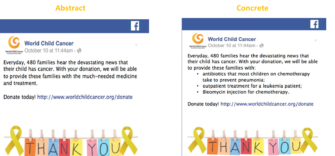A Message Built of Concrete
Should your fundraising message be concrete and specific or abstract? Most would probably say the former and most would be correct.
The better question is why? Why does being more concrete and specific with messaging versus generic and abstract work better? It isn’t enough that the answer to the first question (concrete or abstract?) seems clear and obvious.
Understanding the next level, ‘why’ question gives you foundational insights, which are the building blocks for thinking about the next fundraising product or campaign.
In a lab experiment the Concrete ad garnered more donations. But, this isn’t an A/B test for practitioners to declare victory and run the Concrete one at full speed ahead.

The Concrete one needs a lot of work before it should be released into the wild but again, this wasn’t the point.
Consider this basic vs. applied research, the kind of testing most practitioners can’t justify with donor dollars. It’s a gift of learning and insight to know why something works and then build a good, practitioner informed execution of it.
This research including survey measures after the donation task measuring,
- Empathy
- Elaboration
- Credibility
- Transparency
The Concrete ad created a greater sense of all 4 for the test group that saw it. First off, what the hell is elaboration?
It’s a wonky academic term that means people put a bit more time and mental energy into thinking about the message. That extra bit of thinking is what created more empathy.
And a more concrete message seems more credible. It’s something you could verify if you wanted to. You won’t but just knowing you could makes it seem more credible. It’s that extra credibility that increases the sense of transparency.
In summary, the foundational, use it again and again, insight is that Concrete messaging beats abstract because it,
- Has us put in a tad more mental energy (Elaboration) → which creates more Empathy
- Seems more Credible → Feels more Transparent
Kevin


